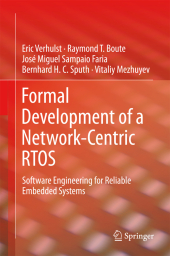 Neuerscheinungen 2014Stand: 2020-02-01 |
Schnellsuche
ISBN/Stichwort/Autor
|
Herderstraße 10
10625 Berlin
Tel.: 030 315 714 16
Fax 030 315 714 14
info@buchspektrum.de |

Raymond T. Boute, José Miguel Sampaio Faria, Eric Verhulst
(Beteiligte)
Formal Development of a Network-Centric RTOS
Software Engineering for Reliable Embedded Systems
2011. 2014. xvii, 219 S. 9 Tabellen. 235 mm
Verlag/Jahr: SPRINGER, BERLIN; SPRINGER US; SPRINGER 2014
ISBN: 1-489-99288-X (148999288X)
Neue ISBN: 978-1-489-99288-8 (9781489992888)
Preis und Lieferzeit: Bitte klicken
This book describes a formally developed, network-centric Real-Time Operating System, OpenComRTOS. Using the formal methods described in this book produces results that are more reliable and will have higher performance.
Many systems, devices and appliances used routinely in everyday life, ranging from cell phones to cars, contain significant amounts of software that is not directly visible to the user and is therefore called "embedded". For coordinating the various software components and allowing them to communicate with each other, support software is needed, called an operating system (OS). Because embedded software must function in real time (RT), a RTOS is needed. This book describes a formally developed, network-centric Real-Time Operating System, OpenComRTOS. One of the first in its kind, OpenComRTOS was originally developed to verify the usefulness of formal methods in the context of embedded software engineering. Using the formal methods described in this book produces results that are more reliable while delivering higher performance. The result is a unique real-time concurrent programming system that supports heterogeneous systems with just 5 Kbytes/node. It is compatible with safety related engineering standards, such as IEC61508.
Part I: Trustworthy Embedded Systems.- Introduction: OpenComRTOS Role in a Unified Systems Engineering Methodology.- Requirements and Specifications for the OpenComRTOS Project.- Part II: Formal Modeling Fundamentals.- The Choice of TLA+/TLC: Comparing Formal Methods.- Basic Formal Specification in TLA+.- Part III: OpenComRTOS Design.- Formal Modelling of the RTOS Entities.- Final Architecture of the RTOS.- Task Interaction Models in OpenComRTOS.- Results: Code Size and Performance.- Part IV: Appendix.- OpenComRTOS-Suite 1.3 Usage Tutorial.- Foundations for TLA+ and Temporal Logic.- Comparison of Formal Methods.- List of Figures.- List of Tables.- Glossary.- References.- Index.


